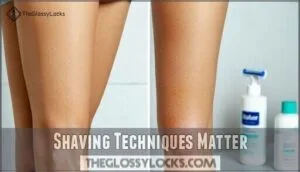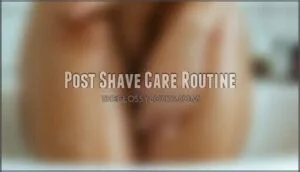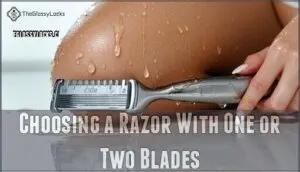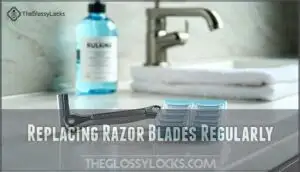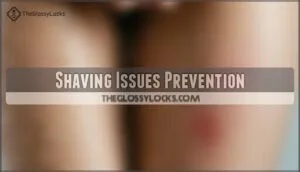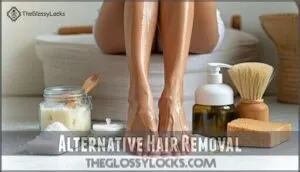This site is supported by our readers. We may earn a commission, at no cost to you, if you purchase through links.
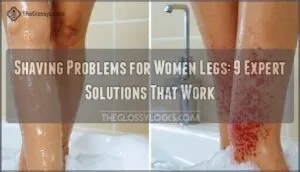 Shaving problems for women legs typically stem from poor technique and inadequate skin prep.
Shaving problems for women legs typically stem from poor technique and inadequate skin prep.
You’re likely dealing with razor burn, ingrown hairs, or irritating bumps because you’re shaving against the grain, using dull blades, or skipping essential steps.
The biggest culprits? Dry shaving, pressing too hard, and forgetting to moisturize afterward.
Your skin needs warm water to soften hair, a quality shaving gel for protection, and gentle strokes following hair growth direction.
Replace your razor every 5-7 shaves and never share it with others.
Post-shave care matters just as much – a soothing moisturizer prevents that tight, itchy feeling that ruins your confidence.
Table Of Contents
Key Takeaways
- Prepare your skin properly – You’ll prevent most irritation by dampening your legs with warm water, exfoliating gently to remove dead skin, and using a quality shaving gel that sits for 2-3 minutes to soften hair.
- Use the right technique and tools – You should shave in the direction of hair growth with a sharp razor, replace blades every 5-7 shaves, and never press too hard or dry shave.
- Focus on post-shave care – You’ll maintain smooth skin by applying a fragrance-free moisturizer within 3 minutes of shaving, then moisturizing daily to prevent dryness and irritation.
- Consider alternatives if problems persist – You can explore waxing, sugaring, epilators, or IPL devices for longer-lasting results, or consult a dermatologist for chronic issues like persistent razor burn or ingrown hairs.
Shaving Problems Explained
You’ve likely experienced razor bumps, ingrown hairs, or that uncomfortable burning sensation after shaving your legs.
These common shaving problems affect up to 60% of women and stem from factors like dull blades, improper technique, and inadequate skin preparation.
Most women deal with razor burn, bumps, and irritation because they’re using dull blades the wrong way.
Ingrown Hairs and Razor Burn
Dealing with razor burn legs and ingrown hairs after shaving? You’re not alone—approximately 55% experience these issues.
Razor burn appears as red, irritated patches immediately post-shave, while ingrown hairs develop as bumps when hair curls back into skin.
Preventing ingrowns starts with proper exfoliation methods and soothing ingredients like aloe. Adjusting shaving frequency reduces irritation substantially.
Understanding the difference can help, as razor bumps inflame due to hairs curling back, which leads to ingrown hairs and causes significant discomfort, making soothing ingredients essential for relief.
Folliculitis and Bumps
Shaving bumps and folliculitis affect up to 60% of women who shave their legs.
These red, pus-filled bumps develop when hair follicles become inflamed or infected, often from dull razors or shaving against the grain.
Causes include bacterial infections like Staphylococcus aureus.
Symptoms range from itchy red spots to painful clusters.
Prevention involves sharp razors and proper technique.
Treatment includes warm compresses and topical antibiotics for severe cases.
It’s basically an inflammation of follicles that can occur anywhere hair grows.
Dryness and Itchiness
Beyond bumps and irritation, your legs face another common shaving challenge.
Post-shave dryness strikes when shaving strips away your skin’s natural oils, leaving you with that tight, uncomfortable feeling.
This dry skin shaving aftermath causes persistent itchiness that can last for days.
Your skin loses moisture faster after hair removal, making hydration importance crystal clear.
Without proper skin moisturization, you’ll notice increased irritation and visible pores.
Shaving Techniques Matter
Your shaving technique can make the difference between smooth, irritation-free legs and a battlefield of bumps and razor burn.
The way you handle your razor, prep your skin, and follow through with aftercare determines whether you’ll love or dread your next shave, as it is crucial for achieving irritation-free results.
Shaving in The Direction of Hair Growth
Going with the grain transforms your shave from a battle into a breeze.
When you follow your hair’s natural direction, you’re working with your skin instead of against it.
This simple shift dramatically reduces irritation and prevents bumps, especially for sensitive skin.
It’s one of the most effective shaving tips women swear by for achieving a smoother shave while maintaining best practices.
Avoiding Shaving Over Cuts and Wounds
Never ignore open wounds when reaching for your razor. Infection prevention becomes your top priority when cuts, nicks, or irritated areas mark your skin. Smart shaving safety means protecting these vulnerable spots from bacteria and further trauma.
Here’s your wound protection checklist:
- Skip the razor – Let healing process run its course naturally
- Clean thoroughly – Rinse cuts with warm water before any hair removal
- Apply barrier protection – Use waterproof bandages over larger wounds
- Consider alternative methods – Try trimming around sensitive areas instead
Shaving over cuts increases scarring risk and delays recovery. Your skin needs time to rebuild its protective barrier. To minimize irritation, consider pre-shave skin preparation. These leg shaving tips prevent complications that turn minor nicks into lasting problems. Remember, patience with wounds today means smoother results tomorrow.
Using Proper Shaving Gel or Cream
Quality protection starts with your shaving cream choice. Fragrance-free, alcohol-free formulations prevent post-shave irritation while creating essential lubrication.
Let shaving gel sit for 2-3 minutes to soften hair effectively. Sensitive skin benefits from cream application over traditional gels.
Many users prefer to buy fragrance-free options for sensitive skin.
| Product Type | Best For |
|---|---|
| Fragrance-free gel | Sensitive skin, daily use |
| Moisturizing cream | Dry skin, winter months |
| Clear gel formulas | Precision shaving areas |
| Foam alternatives | Quick application needs |
| Natural ingredient bases | Chemical-sensitive users |
Pre Shave Care Essentials
Your skin needs proper preparation to avoid the painful aftermath of poor shaving technique.
Start with warm water to soften hair follicles, exfoliate gently to clear dead skin cells.
Then apply a quality moisturizer that won’t clog your pores.
Dampening Skin With Warm Water
Warm water is your secret weapon against leg shaving problems.
Before you reach for that razor, spend a few minutes letting warm water work its magic on your skin.
The heat opens your pores and softens stubborn hair follicles, making each strand easier to cut cleanly.
This simple step reduces shaving irritation and razor burn legs by preparing your skin for a smoother glide.
Time your shave toward the end of your shower when hydration importance peaks and hair softening reaches its maximum potential.
Exfoliating to Prevent Ingrown Hairs
Exfoliating legs before shaving creates your secret weapon against ingrown hairs and shaving tips women swear by. Dead skin cells trap hair beneath the surface, causing those pesky bumps that plague leg shaving problems.
You can find a suitable ingrown hair solution online.
- Exfoliation methods: Use gentle circular motions with dry brushing or sugar scrubs
- Scrub ingredients: Look for salicylic acid or glycolic acid to prevent keratosis pilaris
- Exfoliation frequency: Exfoliate 2-3 times weekly, never immediately before shaving
- Preventing folliculitis: Focus on areas prone to ingrown hairs like ankles and knees
- Timing matters: Exfoliate 24 hours before shaving for ideal results
Using a Non-comedogenic Moisturizer
After exfoliating removes dead skin cells, you’ll want to prep your skin with a noncomedogenic moisturizer before shaving.
These formulas won’t clog pores while providing essential skin hydration. For sensitive skin, look for fragrance-free options with ceramides or glycerin.
Apply daily, not just when shaving—consistent moisturizing legs creates a protective barrier that prevents irritation and supports smoother hair removal results.
Post Shave Care Routine
Your skin needs immediate attention after shaving to prevent irritation and maintain smoothness. Proper post-shave care repairs your skin barrier and keeps your legs comfortable between shaving sessions.
Applying a Soothing Moisturizer
After shaving, your skin craves relief from the irritation it just endured. Applying a soothing moisturizer within three minutes of shaving locks in skin hydration while your pores remain open.
Look for moisturizer ingredients like aloe vera, ceramides, and hyaluronic acid that calm inflammation and restore your skin’s barrier. Choose fragrance-free, alcohol-free body lotion to avoid stinging sensitive skin.
Different moisturizer types work better for various skin sensitivity levels—lightweight lotions suit oily skin while cream-based formulas benefit dry skin. This simple shaving and moisturization routine delivers long-term benefits, preventing the dreaded "strawberry legs" appearance.
Daily Moisturizing for Hydration
Post-shave moisturizer application sets the foundation, but daily moisturization transforms your skin’s long-term health. You’ll discover hydration benefits that extend far beyond immediate comfort.
Regular moisturizer ingredients like ceramides and hyaluronic acid work continuously to maintain skin elasticity and prevent dryness between shaves. Application frequency matters more than you think. Daily moisturization creates a protective barrier that makes your next shaving session smoother and less irritating.
Here’s your skin hydration tips roadmap:
- Apply moisturizer every morning and evening, focusing on previously shaved areas
- Choose fragrance-free formulas to avoid sensitivity reactions
- Look for non-comedogenic options that won’t clog your pores
Consistent shaving and moisturization habits produce long-term effects you can see and feel. Your skin becomes more resilient, less prone to razor burn, and maintains that silky smoothness longer.
Top 7 Shaving Solutions
You’ll find the right products can transform your shaving experience from frustrating to flawless.
These seven solutions tackle common leg shaving problems like razor burn, ingrown hairs, and irritation with proven results.
1. Gillette Venus Deluxe Smooth Swirl Razor
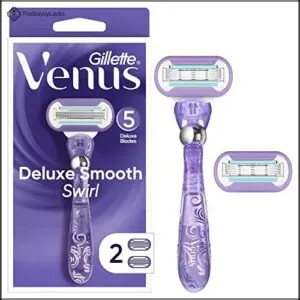
One game-changer stands out when tackling stubborn razor burn and irritation.
The Gillette Venus Deluxe Smooth Swirl features five diamond-coated blades that glide effortlessly over curves, reducing nicks by up to 50%.
Its FlexiBall handle twists in four directions, adapting to tricky ankle and knee areas where most razors fail.
Water-activated moisture strips with Vitamin E create a protective barrier, while the microcomb lifts hair for cleaner cuts.
Each blade lasts 30 days with proper care, making this investment worthwhile for consistently smooth results.
Best For: Those with sensitive skin or trouble areas (like knees and ankles) seeking a smooth, irritation-free shave.
- Blade refills are pricier than standard triple-blade options.
- Moisture strip may degrade quickly if the razor isn’t dried properly after use.
- Mounting sticker for the shower holder can leave residue and isn’t always reliable.
- FlexiBall handle adapts to body contours for fewer missed spots and effortless shaving, even on tricky areas.
- Five diamond-coated blades and moisture ribbon provide a close shave with less risk of nicks and irritation.
- Blade refills last up to 30 days and are compatible with most Venus handles.
2. BIC Soleil Comfort Women’s Razors

With four flexible blades that bend and flex around your legs’ curves, BIC Soleil Comfort razors deliver smooth results without breaking your budget.
The coconut milk moisture strip reduces friction and irritation, making them ideal for sensitive skin.
Users rave about their longevity—lasting 5-10 shaves per razor—and praise their ability to prevent razor burn and bumps.
The rubber grip handle gives you confident control, even in slippery shower conditions.
Best For: Sensitive skin, beginners, and anyone wanting an affordable, easy-to-use razor for travel or daily touch-ups.
- Moisturizing coconut milk strip helps prevent irritation and bumps, especially on sensitive skin.
- Long-lasting blades (5-10 uses) offer good value and reliable performance.
- Rubber grip and pivoting head provide safe, comfortable control even in the shower.
- Moisture strip wears down after several uses, reducing effectiveness.
- Not as sharp or close-cutting as some luxury razors.
- Disposable design creates more waste and isn’t refillable.
3. Schick Intuition f.a.b. Women’s Razor
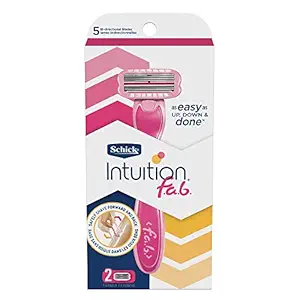
Every busy woman knows the struggle of rushed leg shaves that leave you nicked, bumpy, and frustrated.
The Schick Intuition f.a.b. Women’s Razor changes this game completely with its revolutionary bi-directional technology.
You’ll shave both up and down without lifting the razor, cutting your routine time in half.
The moisture gel on both sides creates an effortless glide while skin guards prevent cuts.
At around $10 for the starter kit, it’s a budget-friendly solution that delivers smooth legs for up to two days.
Best For: Busy women and beginners who want a quick, safe, and effortless shave with less risk of nicks or irritation.
- Shaves both up and down thanks to bi-directional blades, cutting shaving time in half.
- Moisture gel and skin guards provide a smooth glide, reducing nicks and irritation even on sensitive skin.
- Ergonomic handle offers great control, and the razor is compatible with popular handles.
- Refills can be pricey, and finding them in stock is sometimes difficult.
- Moisture strips tend to wear out quickly, especially in disposable versions.
- Blade effectiveness and cartridge attachment may decline over time.
4. Schick Hydro Silk Razor Trimmer
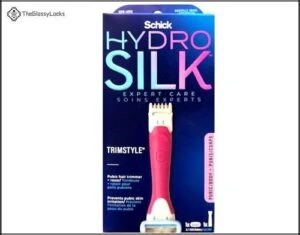
The Schick Hydro Silk Razor Trimmer combines convenience and versatility in one sleek device.
You’ll get five curve-sensing blades with skin guards that minimize irritation, plus a waterproof trimmer with four length settings for precise bikini area grooming.
The water-activated Hydra-Boost serum with shea butter hydrates your skin for up to two hours post-shave.
While some users report the handle can get slippery and the trimmer may pull occasionally, this dual-function tool eliminates the need for separate devices and delivers consistently smooth results with minimal irritation.
Best For: Anyone wanting a waterproof, all-in-one bikini trimmer and razor that minimizes irritation and hydrates sensitive skin.
- Handle can be slippery when wet, making grip tricky.
- Trimmer may pull hair or stop working after water exposure.
- Replacement blades and batteries add ongoing cost.
- Dual-function design shaves and trims, saving space and time.
- Hydra-Boost serum hydrates skin and reduces post-shave dryness.
- Curve-sensing blades and skin guards deliver smooth, gentle results.
5. eos Lavender Shaving Cream for Women
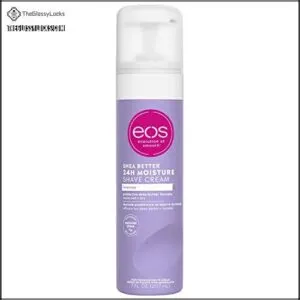
This TikTok-viral shaving cream brings spa vibes to your shower routine with its lavender, sandalwood, and amber scent.
You’ll love how its 24-hour moisturizing formula with shea butter and aloe keeps your skin soft long after shaving.
The non-foaming cream works wet or dry, making it perfect for those rushed mornings or leisurely self-care sessions.
It’s gynecologist-tested for sensitive areas and hypoallergenic, so you won’t worry about irritation on your legs or bikini line.
Best For: Anyone looking for a moisturizing, gentle shaving cream that’s safe for sensitive skin, including the bikini line.
- Delivers 24-hour moisture and leaves skin smoother and softer than foam creams.
- Hypoallergenic, dermatologically and gynecologist-tested, suitable for sensitive or eczema-prone skin.
- Vegan, cruelty-free, and made with natural shea butter and soothing aloe.
- Scent may be too mild or not appealing to everyone.
- Some find it hard to dispense the last portion from the pump.
- Not a substitute for heavy moisturizers if you have very dry skin.
6. Skintimate Sensitive Skin Shave Gel
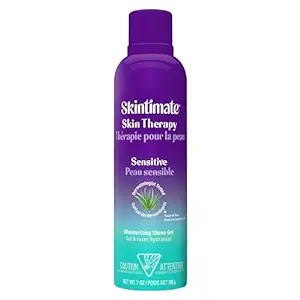
When sensitive skin meets razor, you need gentle protection that won’t let you down.
Skintimate Sensitive Skin Shave Gel delivers dermatologist-designed care with aloe, vitamin E, and olive butter that nourish while you shave.
This hypoallergenic, fragrance-free formula creates a rich lather that prevents nicks and razor burn.
It’s PETA-certified cruelty-free and contains no parabens or sulfates, making it perfect for allergy-prone skin that needs extra TLC.
Best For: Anyone with sensitive, allergy-prone, or easily irritated skin who wants a gentle, fragrance-free shave.
- Dermatologist-designed, hypoallergenic formula soothes and protects sensitive skin.
- Contains aloe, vitamin E, and olive butter for hydration and smoothness.
- PETA-certified cruelty-free, vegan, and free from parabens, sulfates, and artificial dyes.
- Packaging can be prone to breaking, especially the can lid.
- Moisturizing effect may not be strong enough for those with very dry skin.
- Some users wish the lather was thicker for easier visibility while shaving.
7. Vaseline Advanced Repair Unscented Body Lotion
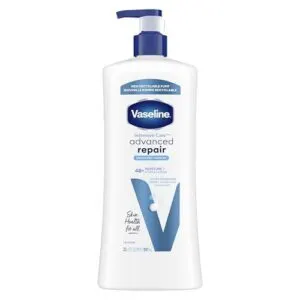
After shaving strips away your skin’s natural oils, you need serious moisture backup.
Vaseline Advanced Repair delivers 90% more hydration than untreated skin, clinically proven to last 48 hours.
Its fragrance-free formula won’t irritate freshly shaved legs, while ultra-hydrating lipids repair your moisture barrier.
You’ll skip the post-shave flakiness and tightness that makes you want to hide under pants, and it’s fast-absorbing and non-greasy, working perfectly with your daily routine.
Best For: People with very dry or sensitive skin—including those who shave regularly—and want long-lasting, fragrance-free hydration without greasiness.
- Clinically proven to deliver 90% more moisture, lasting up to 48 hours
- Fast-absorbing, non-greasy, and gentle for sensitive or post-shave skin
- Fragrance-free and dermatologist-tested, reducing risk of irritation
- Some users report a runny or watery texture
- May not provide enough moisture for severely cracked or damaged skin
- Contains parabens, which some users prefer to avoid
Razor Selection Tips
Choosing the right razor makes all the difference between smooth legs and razor burn nightmares.
You’ll want to focus on blade count, replacement timing, and proper storage to avoid common shaving mishaps.
Choosing a Razor With One or Two Blades
Your razor blade count directly impacts skin sensitivity and shaving frequency. Single or twin-blade razors reduce razor drag and irritation compared to multi-blade options.
Here’s why fewer blades work better for womens leg shaving:
- Reduced skin trauma – Less friction per pass
- Lower irritation risk – Fewer blade contacts minimize redness
- Easier maintenance – Simple cleaning prevents bacterial buildup
- Better blade material exposure – Sharp edges stay effective longer
- Improved shaving techniques – More control over pressure and angle
Choose quality razor blades over quantity for healthier legs. Consider using a single blade option for superior results.
Replacing Razor Blades Regularly
Fresh blades make all the difference in your shaving routine.
Replace razor blades every five to seven shaves to maintain sharpness and prevent irritation.
Dull blades drag across skin, causing razor burn and increasing infection risk.
While blade replacement frequency affects cost, the environmental impact remains minimal compared to treatment products you’ll need otherwise.
Storing The Razor in a Cool, Dry Place
Where you keep your razor matters more than you’d think.
Proper storage prevents bacteria buildup and extends blade life substantially.
- Cool, dry location – Avoid humid bathroom cabinets or shower caddies
- Air circulation – Let the razor dry completely between uses
- Clean surface – Store on sanitized countertops or dedicated razor stands
- Separate storage – Keep away from other personal care items
This simple habit prevents rust formation while maintaining ideal performance and safe storage conditions.
To further prevent corrosion, consider using a blade protector.
Shaving Issues Prevention
You can dramatically reduce shaving problems by building better habits and swapping out dull blades before they wreak havoc on your skin.
Fresh, sharp razors prevent the dragging and pulling that leads to razor burn, while consistent pre- and post-shave routines keep irritation at bay, by using sharp razors.
Building Healthier Shaving Habits
Why do some people struggle with leg shaving while others make it look effortless? The difference often lies in building healthier shaving habits through mindful shaving practices.
Creating a consistent routine transforms your approach from rushed afterthought to intentional self-care ritual. Start with gentle exfoliation before each shaving session to prevent clogged follicles and ingrown hairs.
Your skin barrier needs proper hydration focus, so never skip moisturizing. Mindful shaving means slowing down and paying attention to pressure, direction, and technique. One key is to avoid shaving against grain to minimize irritation.
Develop shaving tips that work specifically for your skin type and hair texture. Address common shaving problems by establishing a predictable shaving routine that includes pre-prep, proper technique, and post-care. Consistency beats perfection every time when preventing leg shaving issues.
Avoiding Dull Blades and Razor Burn
Using a dull razor is like trying to cut paper with a butter knife – it creates more problems than it solves.
Dull blades require extra shaving pressure, which damages your skin and causes razor burn. Replace your razor every five to seven shaves to maintain blade sharpness.
Signs you need a new blade include pulling, tugging, or requiring multiple passes over the same area. Poor razor maintenance leads to bacterial buildup and increased skin sensitivity.
Sharp blades glide smoothly with minimal pressure, reducing irritation. Remember, gentle strokes work better than aggressive scraping.
Quality exfoliation before shaving helps blades work more effectively, preventing common shaving mistakes that leave your legs looking angry and feeling uncomfortable.
Alternative Hair Removal
If traditional shaving keeps causing you problems, it’s time to explore alternatives that work differently on your legs.
These methods target hair at different levels and can provide longer-lasting results than daily razor use.
Waxing and Sugaring for Longer Results
Beyond shaving’s daily routine, waxing and sugaring offer freedom from constant maintenance.
These hair removal methods pull hair from the root, delivering results that last 3-6 weeks compared to shaving’s few days.
Key benefits of waxing vs shaving:
- Longlasting hair removal – Results persist weeks, not days
- Reduced hair regrowth – Hair grows back finer over time
- Less skin sensitivity – No daily razor irritation or nicks
- Smoother finish – Complete hair removal from follicle level
While sugaring technique uses natural ingredients and may cause less pain management issues, both methods require tolerance for temporary discomfort.
Professional treatments guarantee proper technique and minimize complications.
Depilatory Creams for Hair Removal
Depilatory creams dissolve hair at the skin’s surface through chemical reactions, offering a pain-free alternative to shaving.
These hair removal methods work by breaking down keratin proteins in hair shafts.
However, skin sensitivity varies, and patch testing prevents adverse reactions.
While convenient, hair regrowth occurs within days, similar to leg shaving.
| Pros | Cons |
|---|---|
| Pain-free application | Potential skin irritation |
| No risk of cuts | Chemical smell during use |
| Smooth results | Hair regrowth within 3-7 days |
| Easy cream application | May not work on coarse hair |
| Quick hair removal process | Requires patch testing first |
Product comparison reveals different formulations for sensitive skin versus normal skin types.
Always follow manufacturer instructions and avoid leaving cream on longer than recommended to prevent chemical burns.
Epilators and IPL Devices for Root Removal
Epilators and IPL devices offer root removal solutions that outlast shaving cream methods.
Epilators physically pull hair from follicles, causing moderate pain but delivering four weeks of smoothness.
IPL effectiveness reaches 95% reduction with consistent treatment sessions, though device costs run higher.
Both options accommodate varying skin sensitivity levels.
While epilating legs provides instant results, laser hair removal alternatives like IPL require patience for gradual, semi-permanent outcomes through scheduled maintenance sessions.
Maintaining Smooth Skin
You don’t have to accept razor burn, ingrown hairs, and constant irritation as part of your leg-shaving routine.
With the right maintenance approach, you can achieve consistently smooth skin while minimizing common shaving problems.
Using Exfoliating Scrubs and Moisturizers
Consistent exfoliation prevents ingrown hairs while moisturizing maintains your skin’s natural barrier after shaving.
Regular body moisturizer application supports skin hydration tips that dermatologists recommend for ideal results.
Here’s your maintenance routine:
- Exfoliation Benefits: Use an exfoliating scrub 2-3 times weekly to remove dead skin cells
- Moisturizer Types: Choose fragrance-free formulas to avoid ingredient sensitivity reactions
- Post-Exfoliation Care: Apply body moisturizer immediately after scrubbing for maximum skin moisturization
This combination keeps your legs smooth between shaves while supporting healthy skin hydration tips.
Considering Chemical Depilatories or Laser Removal
When scrubs and moisturizers aren’t enough, chemical depilatories and laser hair removal offer compelling alternatives.
Depilatory pros include quick, painless application at home, while laser cons involve higher upfront costs and multiple sessions.
Cost comparison favors laser long-term despite initial expense, and pain levels remain minimal for both methods.
Chemical depilatory provides temporary smoothness, while laser hair removal delivers lasting results through permanent follicle damage.
For longer-lasting results, consider exploring electrolysis procedures.
Consulting a Dermatologist for Advice
When shaving doesn’t play nice with your skin despite trying everything, it’s time to call in the pros.
A dermatologist can tackle persistent issues like chronic ingrown hairs, razor burn, or skin irritation that won’t quit.
They’ll assess severe cases and create personalized skincare solutions, from prescription treatments to alternative options like laser hair removal for stubborn problems.
Frequently Asked Questions (FAQs)
Does shaving legs have any side effects?
Yes, you can experience razor burn, ingrown hairs, folliculitis, cuts, and skin irritation. Using proper technique and sharp razors reduces these risks substantially.
Is shaving good for women’s body?
Like a double-edged sword, shaving offers smooth skin but comes with trade-offs.
You’ll get quick hair removal and soft legs, but risk razor burn, ingrown hairs, and skin irritation.
It’s neither inherently good nor bad—just a personal choice.
How often should I change razor blades?
Replace your razor blades every five to seven shaves or every two weeks.
Dull blades cause dragging, nicks, razor burn, and bacterial infections.
You’ll know it’s time when the blade feels rough or pulls at your hair.
Can I share razors with family members?
No, you shouldn’t share razors with family members. Sharing razors heightens the chance of infection due to transfer of bacteria and skin cells between users, creating health risks.
What causes dark spots after shaving legs?
Like shadows that linger after sunset, dark spots emerge when hair follicles become clogged with dead skin, bacteria, and leftover hair fragments.
This creates "strawberry legs" – those stubborn dark pores that won’t disappear, forming a persistent problem due to the clogging of hair follicles with dead skin.
Should I shave legs daily or weekly?
Daily shaving isn’t necessary and can increase irritation risk.
Most women shave every 2-3 days or weekly, depending on hair growth rate and personal preference.
Less frequent shaving allows skin recovery time.
Why do my legs feel rough immediately?
Your freshly shaved legs might feel like sandpaper because you’re dealing with razor burn or irritation.
Dull blades, dry shaving, or pressing too hard causes immediate roughness and inflammation around hair follicles, which can be described as razor burn.
Conclusion
Smart habits prevent irritation. Proper technique eliminates bumps. Quality products deliver results.
These fundamentals transform your shaving experience from frustrating to flawless. Most shaving problems for women legs disappear when you prep correctly, use sharp blades, and follow hair growth direction.
Don’t rush the process—your skin deserves gentle care. Replace razors regularly, moisturize daily, and never dry shave.
With these expert solutions, you’ll achieve smooth, comfortable legs every time while avoiding common pitfalls that cause discomfort, by following these expert solutions.
- https://my.clevelandclinic.org/health/diseases/23583-razor-burn
- https://www.medicalnewstoday.com/articles/325886
- https://www.skincare.com/skin-concerns/all-skin-concerns/shaving-mistakes-when-shaving-your-legs-and-how-to-fix-them
- https://www.aad.org/public/everyday-care/skin-care-basics/hair/razor-bump-prevention
- https://tresswellness.com/blogs/news/how-to-shave-your-legs-the-right-way

